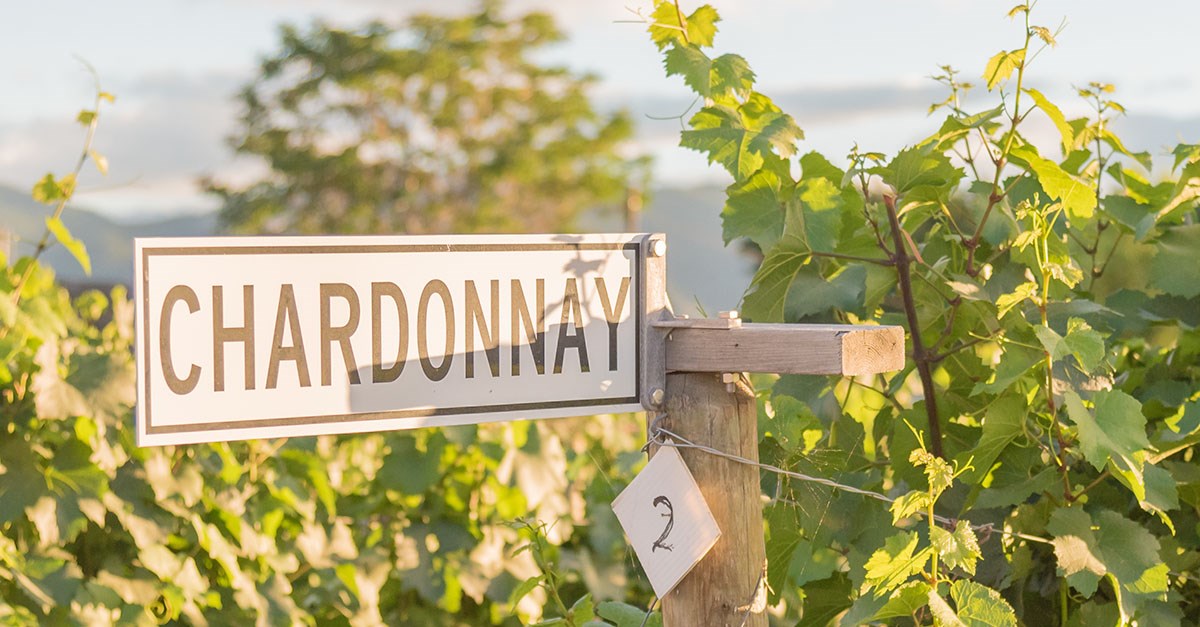Wine lovers worldwide celebrate International Chardonnay Day on the Thursday before the last Monday of May; this year, on May 26. Chardonnay is without a doubt the queen of white grapes, and it deserves to be commemorated. The full-bodied white variety is hard not to love!
Let’s talk about Chardonnay and the delicious wines made from it. Is Chardonnay dry or sweet? What does Chardonnay taste like? Where is Chardonnay grown? Here’s all you wanted to know about the famous wine grape. Let’s explore Chardonnay wine and all its secrets. It’s Chardonnay day, after all!
About the International Chardonnay Day
Chardonnay Day is an international initiative that brings producers, retailers, restaurants and wine lovers around the table to celebrate the noble Burgundian white grape. Chardonnay Day is celebrated on May 26, and for a good reason.
In the northern hemisphere, Chardonnay grapes are picked in Fall, and although some wines spend an average of six months on oak barrels, by May 26, most Chardonnay wine is bottled and on the shelves ready for the taking.
Chardonnay day is an excuse to open a few bottles of golden wine, but it’s also a chance to learn all about the world’s most famous white grape. Chardonnay day encourages people to drink wine, but most importantly, it offers the possibility to learn more about it. Not all Chardonnay is created equal, and it’s in the grape’s diversity where you’ll find the most pleasure.
What Is Chardonnay All About?
Chardonnay is an ancient wine grape, the offspring of the equally famous Pinot Noir and the relatively unknown Gouais Blanc. It comes without saying, some of the most age-worthy and expensive renditions of the white grape come from its spiritual home, Burgundy, France.
Today, Chardonnay is the most planted white variety in the world, and it grows in every single wine-producing country worldwide. Chardonnay can produce a wide variety of wine styles, and it’s known as the “winemaker’s grape”. You can do anything to it, including oak ageing, with spectacular results.
Chardonnay Around the World
Chardonnay is native to Burgundy, and it thrives in every subregion — it produces crisp white wines in Chablis and bold, creamy ones in the Côte d’Or. Chardonnay is also a source of excellent value wine down in Mâcon.
Wines to try:
Olivier Leflaive Meursault 2016
Chardonnay is also California’s darling, and it produces extraordinary results on the coast and the hills, on the North Coast and down south in Santa Barbara.
Wines to try:
Cambria Katherine’s Chardonnay 2019
This well-travelled grape is also the most popular in Australia, South Africa, Chile, Argentina, and even traditional European countries like Spain and Italy!
Wines to try:
Mountadam Five-Fifty Eden Valley Chardonnay 2018
Rochford Single Vineyard Dans Les Bois Chardonnay 2019
We must not forget Chardonnay is also a critical ingredient in sparkling wines Champagne style, in Champagne itself and elsewhere.
Wines to try:
Chardonnay FAQs
Is Chardonnay dry or sweet?
Chardonnay is commonly fermented to dryness, with little to no residual sugar. Still, look hard enough, and you can find a few sweet late harvest wines made with Chardonnay. It’s another story for sparkling wines made with Chardonnay; you’ll find them at all sweetness levels, although Brut styles are prevalent.
Where is Chardonnay grown?
Chardonnay is native to Burgundy, France, but it now grows in every wine-producing country worldwide. California produces a lot of Chardonnay, but you’ll find it planted in the rest of the US, Chile, Canada, Argentina, Uruguay, Spain, England, Italy, South Africa, Australia and New Zealand, to mention a few. Chardonnay is the most planted white grape globally, and it thrives in every wine region despite its type of soil or climate.
What does Chardonnay taste like?
Chardonnay often has scents of golden apples, citrus peels and white flowers. It can also show tropical fruit aromas if grown in warmer climates. If the wine experiences malo-lactic fermentation, you can expect butter and brioche scents, and if oak-aged, you’ll also get cinnamon and vanilla. Not all Chardonnay tastes the same; the practices in the winery can change its personality completely.
On the palate, Chardonnay wine is often dry with medium acidity and medium alcohol. The wine is medium- to full-bodied. If used to make sparkling wine, Chardonnay gives apple and pear aromas to the fizzy wine and a creamy palate.
At what temperature should you serve Chardonnay?
Chardonnay produces complex and full-bodied white wines, best enjoyed close to 10°C (50°F). If un-oaked and fruity, you can serve it a bit colder, closer to 4°C (39°F). For Chardonnay-based sparkling wine, serve at 4°C or fridge temperature and keep in a bucket filled with ice.
How to store Chardonnay?
Store your bottles in the fridge for short-term storage of up to a week or so. If you’re building a collection, store Chardonnay in a refrigerated wine unit or a cellar at a steady temperature between 10-16°C (50-60°F). Chardonnay is one of the few white wines best enjoyed at cellar temperature — the bolder the wine, the warmer you should serve it.
How long does Chardonnay last?
If safely stored, an average bottle of Chardonnay is best enjoyed during its first three years. If oak-aged, Chardonnay can evolve for five years or more. The finest Chardonnay from selected sites can be delicious after a decade.
If you have already opened a bottle of Chardonnay, close it with an air-tight stopper and consume it safely for around three days if stored in the fridge. Modern preservation systems that use inert gas can preserve wine for weeks and even months.
What to do with leftover Chardonnay?
Leftover Chardonnay is still good to drink for 2-3 days if stored properly, but if you notice it’s gone bad, you can still use it for cooking in creamy sauces or salad dressings. Chardonnay is one of the best white wines for cooking for its flavour intensity and body.
Chardonnay Wine Styles
Chardonnay is a versatile variety that can produce various wine styles. These are the most common.
Un-oaked Chardonnay. If fermented in stainless steel tanks and bottled without ageing, Chardonnay can produce a crisp, vibrant white wine with citrus and apple aromas. These wines hit the shelves just months after harvest, and they’re not meant to age. Enjoy un-oaked Chardonnay within its first three years at 4°C.
Oaked Chardonnay. Chardonnay has a solid affinity for oak, as the brown spice aromas in the wood are compatible with the grape’s fruit-forward personality. Chardonnay is also a sturdy grape that produces concentrated medium- to full-bodied wines, precisely the type of wine you need to withstand a few months in a barrel. The most popular oaked Chardonnays come from France’s Burgundy and California, but many other regions produce the style.
Sparkling wine. Along with Pinot Noir and Meunier, Chardonnay is one of the three grapes used to make Champagne, and many Champagnes are made entirely with the white grape — the famous “Blanc de Blancs.” Every wine region specialising in Traditional Method sparkling wine uses Chardonnay, including those in the New World, Italy’s Franciacorta, South Africa’s Cap Classique and many others.
Chardonnay “On Its Lees” and Malo-lactic Explained
Chardonnay is a neutral grape. Yes, it always has apple, citrus and floral aromas, but it lends itself to many techniques that can change its profile. Two of the most common winemaking tools used for Chardonnay by producers worldwide are malo-lactic fermentation and oak ageing.
Malo-lactic fermentation, also known as secondary fermentation, occurs in all red wines but just in a few white wines. For Chardonnay, though, malo-lactic is quite common. In this natural process, lactic bacteria turn the harsher malic acid in the wine into softer lactic acid, blessing the wine with a rounder mouthfeel and scents reminiscent of butter.
Oak ageing is also typical in wines made with Chardonnay. New oak barrels, made with French or American oak, allow controlled oxidation that gives the wine texture and the loveliest golden colour. Oak also infuses the wine with spice and vanilla aromas. Oak-aged Chardonnay often experiences malo-lactic fermentation as well, producing some of the richest white wines on the planet; they’re age-worthy too!
Not all white wine grapes are compatible with the techniques above, but there are others. Chardonnay, though, is the most popular oak-aged white grape.
Why Are Some Chardonnays So Expensive?
Chardonnay can produce inexpensive everyday wines everywhere, but it’s also the source of some of the priciest white wines in the world. What makes Chardonnay expensive is the quality of the grapes — you can only get extraordinary wine grapes when the soil, sun exposure, orientation and altitude are just right.
The most expensive Chardonnay wines also come from reputable producers, who often spare no expense in producing the finest wines possible. Winemakers in Napa Valley, California, Burgundy, France and Margaret River, Australia, make some of the most sought-after Chardonnays. These wines can age!
How to Pair Chardonnay with Food?
Chardonnay is a food-friendly grape, and wines made with it always have a place on the table. Chardonnay offers a wine style for almost every food family, making it a no-brainer when choosing a bottle for dinner.
Un-oaked Chardonnay is perfect when served with whitefish and seafood, ideally sautéed in butter. Mediterranean food and other light dishes are also great partners for this type of wine.
Oak-aged Chardonnay is full-bodied and bold; it pairs nicely with white meat, from pork loins to roasted birds. Creamy sauces are also nice with Chardonnay, and if creamy and buttery, you’ll want to try it with prawns and lobster.
How to Celebrate International Chardonnay Day?
Now that you know all there is about Chardonnay, it’s time to talk about fun ways of celebrating International Chardonnay Day.
This Chardonnay Day, get your hands on a few bottles of Chardonnay from various parts of the world and call some friends over because there’s no better way of getting to know the grape intimately than with a blind tasting. Of course, have some food around and make the most out of Chardonnay’s versatility at the table.
On behalf of everyone at World Wine, we wish you a happy International Chardonnay Day!

